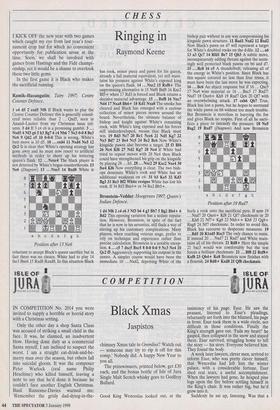CHESS
Ringing in
Raymond Keene
I KICK OFF the new year with two games which caught my eye from last year's tour- nament crop but for which no convenient opportunity for publication arose at the time. Soon, we shall be involved with games from Hastings and the Fide champi- onship, yet it would be a shame to overlook these two little gems.
In the first game it is Black who makes the sacrificial running.
Ramik-Hasangatin; Tatty 1997; Centre Counter Defence.
1 e4 d5 2 exd5 Nf6 If Black wants to play the Centre Counter Defence this is generally consid- ered more reliable than 2 ...Qxd5, seen in Anand—Lautier from my Christmas issue col- umn. 3 d4 If 3 c4 c6 is a promising gambit. 3 ... Nxd5 4 Nf3 g6 5 h3 Bg7 6 c4 Nb6 7 Nc3 0-0 8 Be3 Nc6 9 Qd2 e5 10 0-0-0 This is wrong. White's best move is 10 d5. 10 ...exd4 11 Nxd4 Ne5 12 Qc2 It is clear that White's opening strategy has gone awry and he must now resort to artificial methods in order to shore up his tottering queen's flank. 12 ...Nexc4 The black player is not deterred by White's bogus counterthreats. 13 Ne6 (Diagram) 13 ...Nxe3 14 Rxd8 White is
Position after 13 Ne6
reluctant to accept Black's queen sacrifice but in fact there was no choice. White had to play 14 fxe3 Bxe6 15 Rxd8 Raxd8. In this situation Black has rook, minor piece and pawn for his queen, already a full material equivalent, yet still main- tains his pressure against White's exposed king on the queen's flank. 14 ....Nxc2 15 Rx18 + The unpromising alternative is 15 Nxf8 Bxf8 16 Kxc2 Bf5+ when 17 Rd3 is forced and Black retains a decisive material advantage. 15 ...Bxf8 16 Nxc7 Nd4 17 Nxa8 Bh6+ 18 Kdl Nxa8 The smoke has cleared and Black has emerged with a curious collection of minor pieces strewn around the board. Nevertheless, the ultimate balance of bishop and knight against White's remaining rook, with White's king exposed and his forces still underdeveloped, means that Black must win. 19 Bd3 Nc7 20 Rel Nce6 21 Nd5 Kg7 22 Ne3 Bd7 23 Be4 Nc5 24 Bc2 Bc6 Now White's kingside pawns also become a target. 25 f3 1114 26 Nc4 Kf6 27 Nd2 Kg7 28 Ne4 If White had tried to repeat moves with 28 Nc4 then Black could have strengthened his grip on the kingside by playing 28 ...h5. 28 ...Nxcl 29 Kxc2 Nxe4 30 fxe4 Kf6 Now everything is clear. The two bish- ops dominate White's rook and White has an additional weakness on e4. 31 b3 Ke5 32 K413 Bg3 33 Re3 Bi2 White resigns White has lost his rook. If 34 Rf3 Bxe4+ or 34 Re2 Bb5+.
Bronstein-Vedder: Hoogeveen 1997; Queen's Indian Defence.
1 d4 Nf6 2 c4 e6 3 Nf3 b6 4 g3 Bb7 5 Bg2 11b4+ 6 Bd2 This opening variation has a sedate reputa- tion. However, Bronstein, in spite of the fact that he is now in his seventies, still finds a way of stirring up his customary complications. Many players, when reaching veteran stage, prefer to rely on technique and experience rather than precise calculation. Bronstein is a notable excep- tion. 6 ...c5 7 dxc5 Bxc5 8 0-0 0.0 9 Nc3 Ne4 10 Qc2 f5 Aggressively supporting his outpost in the centre. A simpler course would have been the immediate 10 ... Nxd2, depriving White of the bishop pair without in any way compromising his kingside pawn structure. 11 Rad1 Nxd2 12 Rxd2 Now Black's pawn on d7 will represent a target for White's doubled rooks on the d-file. 12 ...a6 13 a3 Qc7 14 Rfdl Be7 15 Qb3 A subtle move, inconspicuously adding threats against the seem- ingly well protected black pawns on b6 and d7. 15 ...Rc8 16 c5 A thunderbolt, releasing all of the energy in White's position. Since Black has this square covered no less than four times, it must have been the last move he was expecting. 16 ... Bc6 An abject response but if 16 ... Qxc5 17 Na4 wins material or 16 ... Bxc5 17 Rxd7! Nxd7 18 Qxe6+ Kh8 19 Rxd7 Qc6 20 0f7 with an overwhelming attack. 17 cxb6 Qb7 True, Black has lost a pawn, but he hopes to surround the white pawn on b6 without too much trouble. But Bronstein is merciless in harrying the foe and gives Black no respite. First of all he sacri- fices a piece to intensify the pressure. 18 Ne5 Bxg2 19 Rxd7 (Diagram) And now Bronstein
Position after 19 Rxd7 hurls a rook onto the sacrificial pyre. If now 19 ...Nxd7 20 Qxe6+ Kf8 21 Qf7 checkmate or 20
.Kh8 21 Nf7+ Kg8 22 Nh6+ + Kh8 23 Qg8+ Rxg8 24 Nf7 checkmate. In order to avoid this, Black has recourse to desperate measures. 19 Bd5 20 RlxdS Rxc3 The only chance to resist. If instead 20 ...Nxd7 21 Rxd7 and White main- tains all of his threats. 21 Rd8+ Here the simple 21 bxc3 would win comfortably but the text forces a brilliant checkmate. 21 ...1318 22 RAN+ Kxf8 23 Qb4+ Ke8 Bronstein now finishes with a flourish. 24 Rd8+ Kxd8 25 Q18 checkmate.


















































 Previous page
Previous page